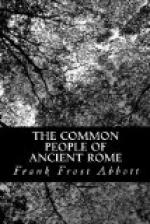and the Milesian tale;
and the prologue of comedy;
and the mime;
the Satirae perhaps a mixture of many types;
originated with Petronius.
Plautus.
Poetry of the common people,
dedicatory;
ephemeral;
graffiti;
borrowed from the Augustan poets;
folk poetry;
children’s jingles.
Pompey,
his benefactions;
ordered to march against Caesar;
et passim in chapter on Curio.
Prices,
controlled by corporations;
attempts at government regulation.
Probus, the “Appendix” of.
Prose-poetic form.
Ritschl, the Plautine scholar.
Romance, the realistic, origin obscure.
(See Petronius, Satirae.)
Romance languages,
causes of their differentiation, Groeber’s
theory;
Ascoli’s theory;
date of their beginning;
descended from colloquial Latin;
reasons of their agreement;
common source.
Romances, the Greek, theory of origin.
Salaries of municipal officers.
(See also Wages.)
Scaptius and Cicero.
Seneca the elder, “Controversiae,”.
Strasburg oath.
Strikes.
Theatres a municipal expense.
Trimalchio’s Dinner.
Umbrian.
Urso, constitution of.
Wages in Roman times;
compared with to-day;
and guilds;
and slavery.
(See also Salaries.)
Footnotes
[1] Cf. A. Ernout, Le Parler de Preneste, Paris, 1905.
[2] The relation between Latin and the Italic dialects may be illustrated by an extract or two from them with a Latin translation. An Umbrian specimen may be taken from one of the bronze tablets found at Iguvium, which reads in Umbrian: Di Grabouie, saluo seritu ocrem Fisim, saluam seritu totam Iiouinam (Iguvinian Tables VI, a. 51), and in Latin: Deus Grabovi, salvam servato arcem Fisiam, salvam servato civitatem Iguvinam. A bit of Oscan from the Tabula Bantina (Tab. Bant. 2, 11) reads: suaepis contrud exeic fefacust auti comono hipust, molto etanto estud, and in Latin: siquis contra hoc fecerit aut comitia habuerit, multa tanta esto.
[3] Corpus Inscriptionum Latinarum, IX, 782, furnishes a case in point.
[4] Cf. G. Mohl, Introduction a la chronologie du Latin vulgaire, Paris, 1899.
[5] Pauly-Wissowa, Real-Encyclopadie, IV, 1179 ff.
[6] Marquardt, Roemische Staatsverwaltung, II, p. 463.
[7] Cf., e.g., Pirson, La langue des inscriptions Latines de la Gaule, Bruxelles, 1901; Carnoy, Le Latin d’Espagne d’apres les inscriptions, Bruxelles, 1906; Hoffmann, De titulis Africae Latinis quaestiones phoneticae, 1907; Kuebler, Die lateinische Sprache auf afrikanischen Inschriften (Arch, fuer lat. Lex., vol. VIII), and Martin, Notes on the Syntax of the Latin Inscriptions Found in Spain, Baltimore, 1909.




